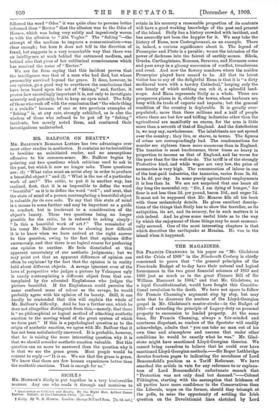31R. BALFOITR ON BEAUTY
MR. BALFOUR'S Romanes Lecture has two advantages over
most other studies in aesthetics. It contains no technicalities to bewilder an uninitiated reader, and no assumptions offensive to his common-sense. Mr. Balfour begins by pointing out two questions which criticism used to ask in the past, but which it now no longer asks. These questions
are : (1) " What rules must an artist obey in order to produce a beautiful object ? " and (2) " What is the use of a particular work of art?" The critic, to put it in another way, has realised, first, that it is as impossible to define the word "beautiful" as it is to define the word "red " ; and next, that the state of mind of a person contemplating a beautiful object is valuable for its own sake. To say that this state of mind is a means to some further end may be important as a guide to conduct, but is irrelevant to a consideration of the object's beauty. These two questions being no longer possible for the critic, he is reduced to asking simply : " Is this a beautiful work of art P" The remainder of his essay Mr. Balfour devotes to showing how difficult it is to know when we have arrived at the right answer to this question, owing to the fact that opinions differ enormously, and that there is no logical reason for preferring one opinion to another. He feels dissatisfied at this apparent uncertainty of our aesthetic judgments ; but we may point out that an apparent difference of opinion can often be explained by the fact that the opinion is in reality held about different objects. A savage ignorant even of the laws of perspective who judges a picture by Velazquez ugly is surely contemplating a different object from that con- templated by the educated Englishman who judges the picture beautiful. If the Englishman could perceive the same confused mass of colour as the savage, he would probably agree with his opinion of its beauty. Still, it can hardly be contended that this will explain the whole of Mr. Balfour's difficulty. And he has a further one, which he does not altogether distinguish from this,—namely, that there is "no philosophical or logical method of attaching aesthetic emotion to the moving wheel of the great system of which we form part." If this is a psychological question as to the origin of aesthetic emotion, we agree with Mr. Balfour that it has not been satisfactorily answered. It is probable, however, that he is raising the more interesting question why it is that we should consider aesthetic emotion valuable. But this question can no more be answered than the question why it is that we see the grass green. Most people would be content to reply :—" It is so. We see that the grass is green. We know that there are few human experiences better than the aesthetic emotions. That is enough for us."






































































 Previous page
Previous page